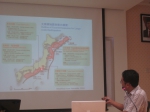Get to Know about Earthquakes: The Source and Damage
BANDUNG, itb.ac.id - Geological Engineering Department ITB and the Association of Indonesian Geologists (IAGI) held a Geology-related webinar on Saturday (6/2/2021). The webinar was titled "Greeting: Solidarity for the Country", invited a presenter, namely Dr. Astyka Pamumpuni S.T., M.T., a lecturer and researcher of the Applied Geology Expertise Group. With the theme "Earthquakes: Its Source and Damage," Dr. Astyka, an active member of the National Center for Earthquake Studies (PuSGeN), focuses his exposure on earthquake sources, hazards, and earthquake events in Indonesia.
Astyka said that it is crucial to know that earthquakes are dangerous phenomena. In the last 20 years, several areas in Indonesia have experienced earthquakes. For example, the Aceh Earthquake in 2004, Yogyakarta Earthquake in 2006, Lombok Earthquake in 2006 and 2018, Palu Earthquake in 2018, to the Majene Earthquake in early 2021.
Usually, earthquakes have their visible path. Unfortunately, the pattern is closed because there are persistent earthquakes in Indonesia, making the distribution of earthquakes in Indonesia is very large. This ugly truth is supported by Indonesia's geographical location, which is located at the junction of the world's three major plates and is in an active tectonic area.
Asthyka said that generally, the earthquakes were caused by faults and subductions. A fault is a discontinuity in the rock that causes rocks to shift; the more significant the rock shift, the greater the earthquake magnitude.
Meanwhile, subduction is the occurrence of a collision in the Earth's zone. "The deeper its subduction will provide greater the magnitude of the earthquake," he said.
Several parameters are usually used to measure earthquakes' potential, such as surface rupture, epicenter, and hypocenter/focus. Focus/hypocenter is a point in the earth that is the center of an earthquake. In general, earthquakes occur in faults with a depth of 10-15 km. "So, if the fault has a depth of about 100 m, it does not have the potential for an earthquake," he said. Conversely, if a fault is at a depth of 10-15 km, the fault has the potential for an earthquake.
Earthquakes have an impact both directly and indirectly, such as shocks, surface tears, liquefaction, rock falls, landslides, and damage to buildings. The indirect effects of earthquakes can result in tsunamis, flooding, fires, and toxic contamination. "As in the 2004 earthquake in Aceh, the source was a subduction that caused a tsunami," he explained.
Asthyka stated that earthquakes are unavoidable. There are no technologies to prevent them, but mitigation will minimize the catastrophic impacts.
"As if we are going to a war zone, we must know what weapons the enemy has," Dr. Astyka said, analogizing disaster mitigation efforts.
Reporter: Deo Fernando and Kevin Agriva Ginting
Translator : Billy Akbar Prabowo (Metallurgical Engineering 2020)

scan for download







